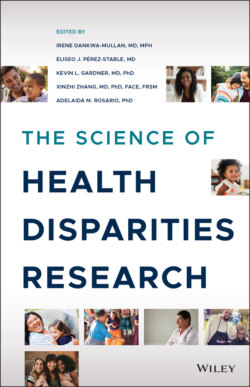Читать книгу The Science of Health Disparities Research - Группа авторов - Страница 17
1.3.3 Health Disparities and Health Disparities Research
ОглавлениеNIMHD defines a health disparity as a health difference, based on one or more health outcomes, that adversely affects defined disadvantaged populations. According to the legislation that created NIMHD, a health disparity population is characterized by a pattern of poorer health outcomes, indicated by the overall rate of disease incidence, prevalence, morbidity, mortality, or survival in the population as compared to the health status of the general population. NIH‐designated health disparity populations were defined in this legislation and the authority to modify these designations was given to the director of NIMHD in consultation with the director of the Agency for Healthcare Research and Quality (AHRQ). Currently designated health disparity populations include the racial/ethnic minority groups mentioned above, populations of less privileged SES or poor persons from any race/ethnic group, under‐served rural populations, and sexual and gender minorities. Health disparities research is devoted to (i) understanding determinants that cause, sustain, or mitigate health disparities; and (ii) how this knowledge is translated into interventions to reduce disparities.
NIMHD's definition of health disparities emphasizes an adverse difference in populations with a social disadvantage. From the NIMHD perspective, a defined difference in health outcomes between populations is not necessarily a disparity. We define disparity as a difference between a disadvantaged population and a more advantaged referent population or the general population.
By comparison, in Healthy People 2020, the contributions of social determinants to an individual's ability to achieve good health also include sex, age, and disability.3 Healthy People 2020 defines a health disparity as “a particular type of health difference that is closely linked with social, economic, and/or environmental disadvantage.” The NIMHD definition emphasizes the disadvantage of population groups, and thus all adverse health outcomes within the designated population groups are considered health disparities. The NIMHD definitions also emphasize the importance of the historical or current link to discrimination or exclusion in determining health and healthcare disparities. The contributions of biological mechanisms, healthcare access and quality, and interventions to ameliorate disparities also need to be considered.
